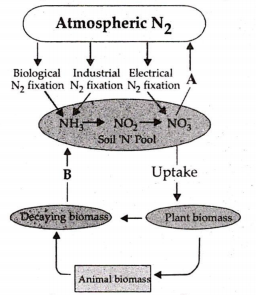 Multiple Choice Questions
Multiple Choice QuestionsAssertion: Soil particles, particularly clay and organic matter in soil, contain negative charges that attract positively-charged ions such as Ca2+, K+ and Mg2+.
Reason: Essential elements derived from soil are termed as mineral elements while those derived from air or water are known as nonmineral elements.
If both assertion and reason are true and reason is the correct explanation of assertion.
If both assertion and reason are true but reason is not the correct explanation of assertion.
If assertion is true but reason is false.
If both assertion and reason are false.
Assertion : Atmospheric nitrogen gas is always fixed by nitrogen-fixing micro-organisms.
Reason : Decomposers release nitrogen gas from dead bodies of plants and animals.
If both assertion and reason are true and reason is the correct explanation of assertion
If both assertion and reason are true but reason is not the correct explanation of assertion
If assertion is true but reason is false
If both assertion and reason are false
Apiculture is associated with which of the following groups of plants
Grapes, maize, potato
Sugarcane, paddy, banana
Guava, sunflower, strawberry
Pineapple, sugarcane, strawberry
Leghaemoglobin is produced in response to
respiration
photosynthesis
fatty acid synthesis
N2 fixation
D.
N2 fixation
Bacteria like Rhizobium and Frankia live free as aerobes in the soil but are unable to fix nitrogen. They develop the ability to fix nitrogen only as a symbiont when they become anaerobic. They are unable to fix nitrogen by themselves. Roots of a legume secrete chemical attractants. Bacteria collect over the root hairs and form an infection thread enclosing the bacteria. Infection thread grows along with multiplication of bacteria. Bacteria stop dividing and form irregular polyhedral structures called bacteroids. In an infected cell, bacteroids occur in groups surrounded by host membrane. The host cell develops a pinkish pigment called leghaemoglobin (Lb). It is oxygen scavenger and is related to blood pigment haemoglobin. It protects nitrogen fixing enzyme nitrogenase from oxygen.
Assertion : Cattles feed on leaves of maize to get nutrition for growth and development.
Reason: A number of symbiotic bacteria are present in rumen of cattle.
If both assertion and reason are true and reason is the correct explanation of assertion.
If both assertion and reason are hue but reason is not the correct explanation of assertion.
If assertion is true but reason is false.
If both assertion and reason are false.
In the given diagram A and B represent

| A | B |
| Mineralisation | Demineralisation |
| A | B |
| Ammonification | Denitrification |
| A | B |
| Denitrification | Ammonification |
| A | B |
| Denitrification | Mineralisation |
Which of the following is correct set of micronutrient for plants?
Mg, Si, Fe, Cu, Ca
Cu, Fe, Zn, B, Mn
Mg, Fe, Zn, B, Mn
Mo, Zn, Cl, Mg, Ca
